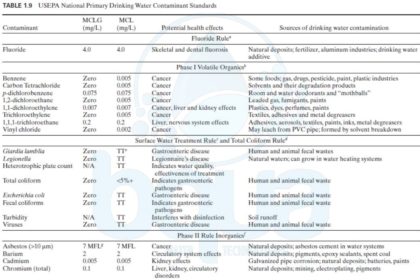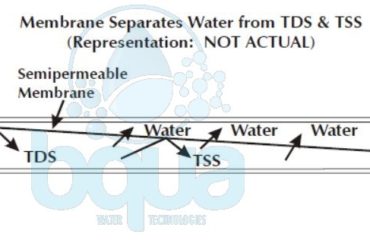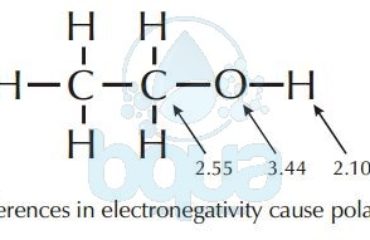
What are the USA Drinking Water Standards
Drinking water standards have been set by a number of countries and international organizations. The number of standards published by these organizations and the frequency of their revision is increasing. Hence, only references for the current standards will be provided so that the most recent version can be obtained from the appropriate agency.
Summary Listing of USA Drinking Water Standards
Current and proposed drinking water standards are summarized in Tables 1.9 to 1.11.The background and current status of anticipated USEPA drinking water regulations are reviewed annually in the Journal of the American Water Works Association (Pontius, 1990a, 1992, 1993a, 1995, 1996a, 1997b, 1998; Pontius and Roberson, 1994).
USEPA Drinking Water Standards USA Table
USEPA Drinking Water Standards USA Table continued
USEPA Drinking Water Standards USA Table continued 2
USEPA Drinking Water Standards USA Table Continued 3
USEPA Drinking Water Standards USA Table Continued 4
Drinking water standards in Canada
In Canada, provision of drinking water is primarily the responsibility of the provinces and municipalities. The federal Department of Health conducts research, provides advice, and in collaboration with the health and environment ministries of the provinces and territories, established guidelines for drinking water standards quality under the auspices of the Federal-Provincial Subcommittee of Drinking Water.A publication entitled Guidelines for Canadian Drinking Water Quality (Health and Welfare Canada, 1996) identifies substances that have been found in drinking water and are known or suspected to be harmful. For each substance, the Guidelines establish the maximum acceptable concentration (MAC) that can be permitted in water used for drinking. The MAC is similar to the USEPA MCL.
Drinking water standards in Mexico
In Mexico, the federal Secretariat of Health has the authority for setting drinking water standards. A national law analogous to the U.S. SDWA does not exist, but Mexico has set standards for a number of microbiological and chemical contaminants that they refer to as norms (Secretariat of Health, 1993). Compliance with the DRINKING WATER STANDARDS, REGULATIONS, AND GOALS 1.39 norms established by the federal government is mandatory.The norms are similar to the USEPA MCLs in that they are set at the federal level, and then the water purveyors are required to conduct monitoring in accordance with the norms and to meet the values set. The standards include sampling and analytical requirements as well as reporting requirements. Implementation is carried out by the Secretariat of Health, other government entities, and the National Water Commission.
Drinking water standards by the World Health Organization (WHO)
The World Health Organization (WHO) is a specialized agency of the United Nations with primary responsibility for international health matters and public health. In carrying out that responsibility, it assembles from time to time international experts in the field of drinking water to establish Guidelines for Drinking water Quality (WHO, 1996).The primary aim of this publication is the protection of public health. These Guidelines are published primarily as a basis for the development of national drinking water standards, which, if properly implemented, will ensure the safety of drinking water supplies by eliminating known hazards. These Guidelines values are not mandatory limits. Each country must consider the Guidelines values in the context of local or national environmental, social, economic, and cultural conditions. They can then select which of the Guidelines are applicable to their situation and may choose to make adjustments to suit local conditions. The issues of monitoring, reporting, and enforcement are solely left to the discretion of the governmental entity using the WHO Guidelines. USEPA is an active participant in the development of the Guidelines, and the procedures used are in some ways similar to those used to develop the U.S. drinking water regulations.
Drinking water standards by the European Union (EU)
The European Union (EU) is a voluntary economic alliance of member states. Through the European Commission, directives are created that must then be adopted and implemented by member states. Therefore, EU members must have enforceable drinking water standards that cannot be less stringent than the limit values set out in the directive. Of course, member states can set more stringent standards if they wish. In July 1980, the Commission adopted directive 80/778/EEC relating to the quality of water intended for human consumption (EEC, 1980). On January 4, 1995, the European Commission adopted a proposal to simplify, consolidate, and update the directive. The proposal reduces the number of parameters from 66 to 48 (including 13 new contaminants), obliges member states to fix values for additional health parameters as needed, adds more flexibility to redress failures, allows efficient monitoring by including a number of indicator parameters, and finally, adds a requirement for annual reports to the consumer (EC, 1996).This proposal was adopted by the Council of the European Union on December 19, 1997 (EU, 1997).
Contact us for more information regarding this article or water treatment options for your water.




